Physical Address
304 North Cardinal St.
Dorchester Center, MA 02124
Physical Address
304 North Cardinal St.
Dorchester Center, MA 02124
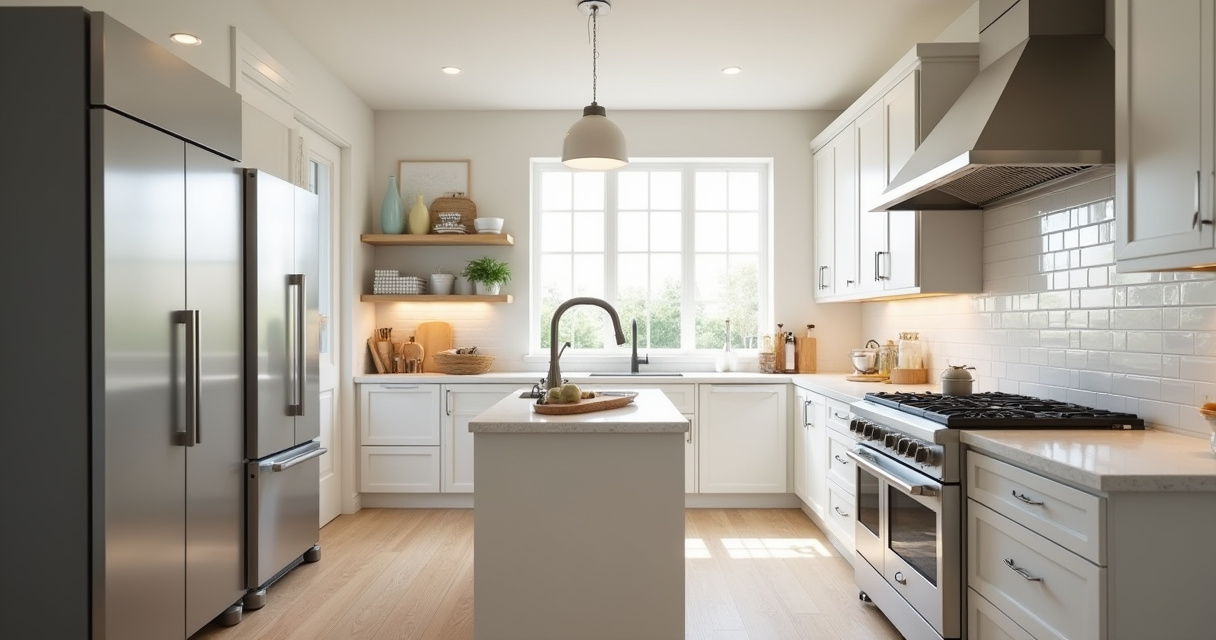
Transform your space with these 24 essential kitchen design tips covering layout, lighting, materials, and personalization to create a beautiful, functional heart for your home.
The kitchen is more than just a place where meals come together—it’s where life happens. Morning coffee rituals, weekend baking projects, impromptu gatherings around the island—these moments define our homes. Yet creating a kitchen that truly works for you requires thoughtful planning that balances aesthetics with practicality.
As an indoor garden specialist who’s designed countless plant-focused spaces, I’ve learned that kitchens require the same careful attention to environmental conditions, flow, and personal lifestyle that my botanical installations do. Whether you’re planning a complete renovation or simply refreshing your current space, these kitchen design tips will help you create a kitchen that’s not just beautiful, but genuinely enhances how you live in your home.
The work triangle—connecting your refrigerator, sink, and range—remains the foundation of efficient kitchen design for good reason. When these three elements form a triangle with legs between 4 and 9 feet each, you create a natural workflow that minimizes unnecessary steps while cooking. The sum of all three legs should ideally stay under 26 feet for optimal efficiency.
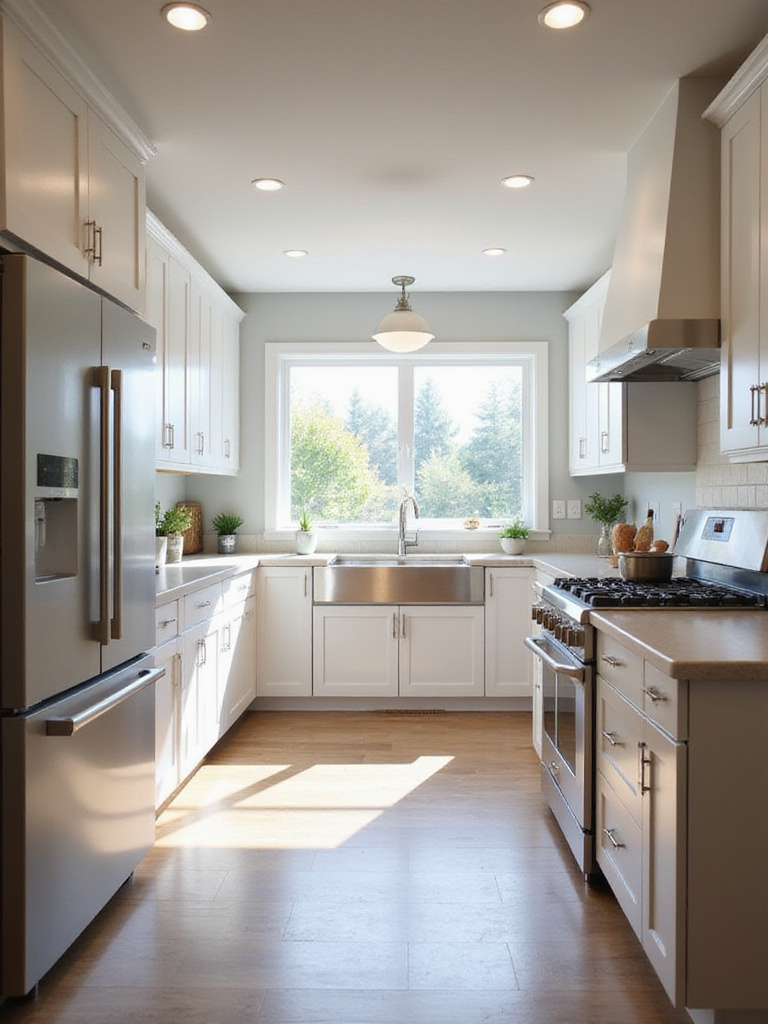
This concept matters because it directly impacts how smoothly you move through your kitchen during meal preparation. A properly designed work triangle reduces physical strain and creates intuitive pathways between the most frequently used areas. For open-concept kitchens, ensure that main traffic paths don’t cut through this triangle, as this disrupts workflow and creates collision points.
The magic of this piece lies in its ability to adapt to different kitchen shapes. Whether you have a galley, L-shaped, or U-shaped layout, the triangle principle can be customized to your space while maintaining its functional benefits.
A cluttered kitchen is an inefficient one. Maximizing storage isn’t just about having enough space—it’s about having the right kind of space for your specific needs. Today’s cabinet innovations go far beyond basic shelves to create purpose-built solutions for everything you own.
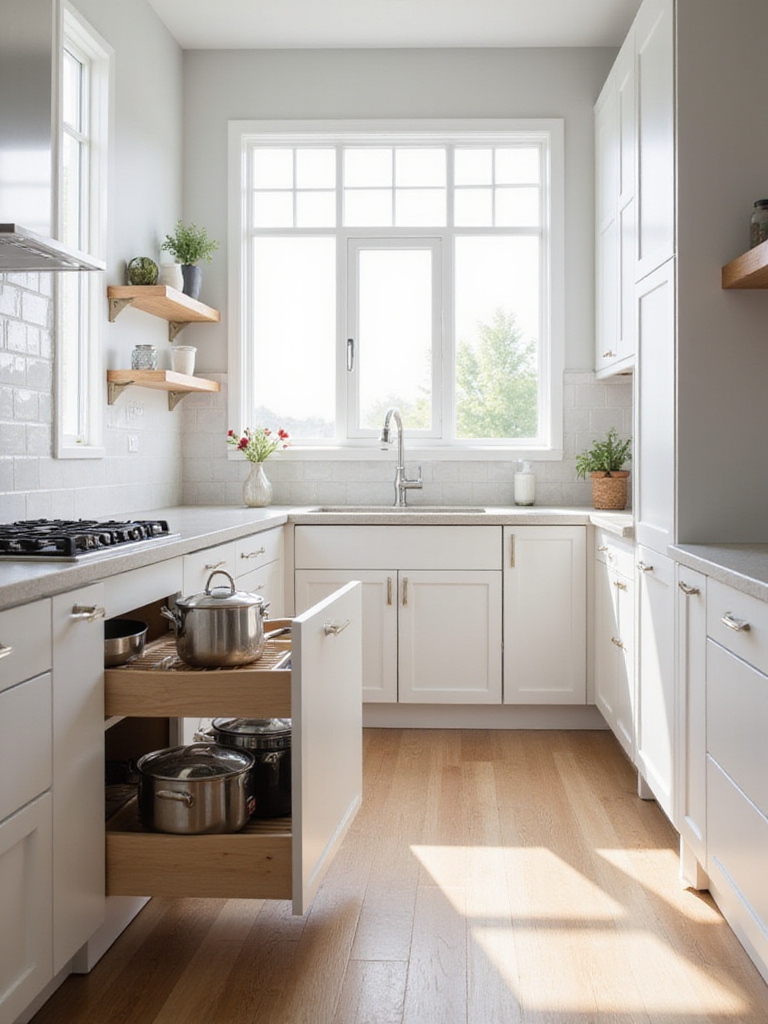
Consider incorporating deep pull-out drawers instead of standard shelves in base cabinets—they bring items at the back within easy reach. Vertical dividers transform awkward cabinet spaces into perfect storage for baking sheets and cutting boards. Blind corner systems with pull-out mechanisms reclaim those notoriously inaccessible corner cabinets. Specialized inserts for spices, utensils, and even appliance garages keep countertops clear while keeping everything accessible.
Running your hand across this material reveals that before selecting storage solutions, take inventory of what you actually need to store. This assessment helps you choose the right mix of specialized storage that truly serves your cooking style rather than generic solutions that waste precious space.
Kitchen lighting requires more thoughtful planning than perhaps any other room because it serves such varied purposes. A well-designed kitchen incorporates three distinct lighting layers: ambient (overall illumination), task (focused light for work areas), and accent (highlighting architectural features or display areas).
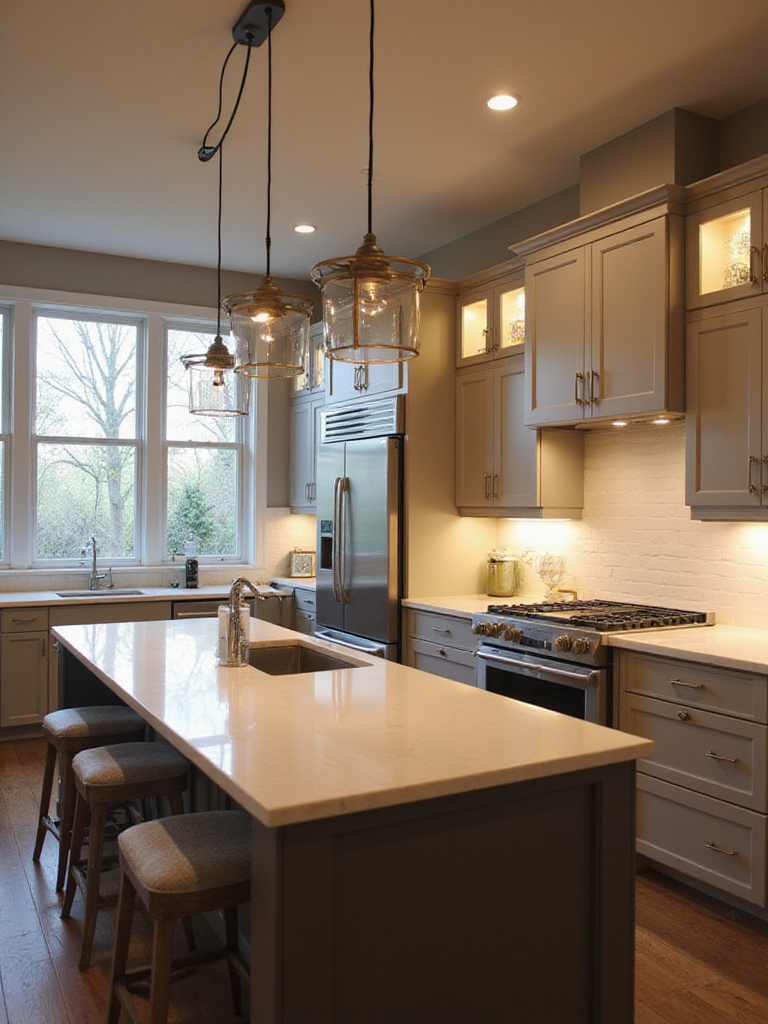
Recessed ceiling fixtures typically provide ambient lighting, establishing general illumination throughout the space. Under-cabinet lighting delivers crucial task lighting that eliminates shadows on countertops where you chop, mix, and measure. Pendant lights over islands or dining areas can serve as both task lighting and visual focal points. Accent lighting might include interior cabinet lighting or directional spotlights that highlight design features or collections.
The visual weight balances perfectly when each lighting layer is controlled by separate dimmers, allowing you to transition from bright, functional lighting for meal prep to a softer, more intimate atmosphere for dining. This flexibility transforms how the kitchen feels throughout the day.
Countertops dominate your kitchen visually and functionally, making material selection one of your most important kitchen design tips to consider. Each option offers a unique combination of aesthetics, durability, and maintenance requirements that should align with your lifestyle.
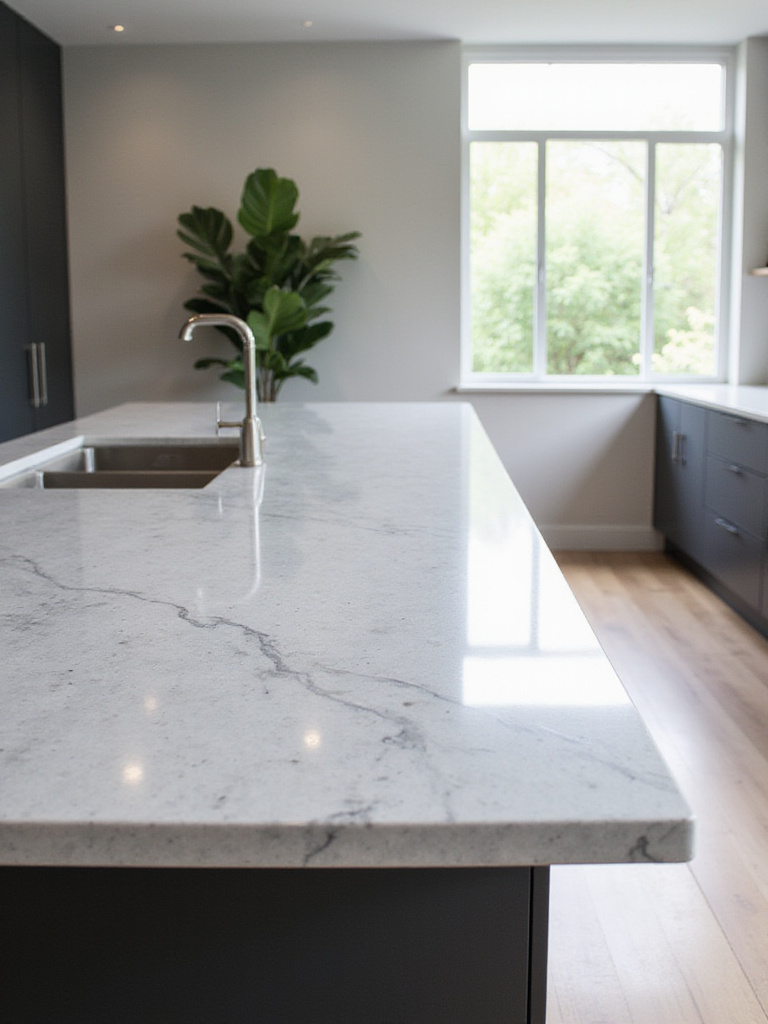
Quartz has become increasingly popular for its exceptional durability and low maintenance. As an engineered stone composed of 90-95% ground natural quartz bound with resins, it resists stains, doesn’t require sealing, and comes in countless patterns and colors. Natural stone options like granite offer unique character with varying patterns and excellent heat resistance, though they require periodic sealing. Butcher block brings warmth and can be sanded and refinished, but needs regular oiling and more careful maintenance around water.
The unexpected environmental benefit comes from considering how your countertop choice affects your daily habits. A material that’s easy to maintain and durable enough to last decades reduces resource consumption over time, making it worth investing in quality that suits your actual cooking patterns.
Appliances are the workhorses of your kitchen, and selecting the right ones involves more than just comparing features and finishes. Energy efficiency should be a primary consideration—not just for environmental reasons, but for the significant impact on your utility bills over the appliance’s lifespan.
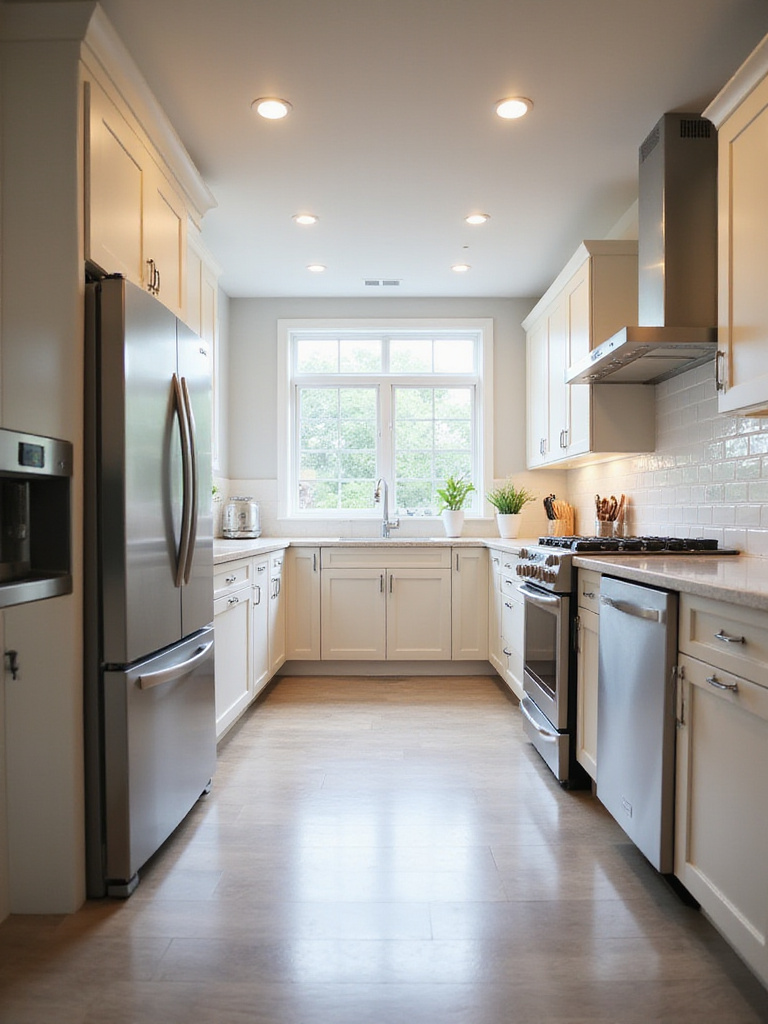
Right-sizing means matching appliance capacity to your actual needs rather than automatically choosing the largest available options. A family of four likely needs different refrigerator capacity than a couple who rarely cooks at home. Consider how you actually use your kitchen: Do you entertain frequently? Bake often? Store mostly fresh or frozen foods? A properly sized dishwasher, refrigerator, or range not only saves energy but also fits better into your workflow and available space.
While trendy, this element has staying power because today’s energy-efficient appliances often incorporate smart technology that can significantly enhance functionality while reducing consumption. Look for the ENERGY STAR label as a baseline, then evaluate specific features that match your cooking habits.
Ergonomics might sound technical, but it’s simply about designing your kitchen to work with your body rather than against it. Considering how you move and work prevents the physical strain that comes from poorly planned spaces. Standard counter heights (36 inches) work for many people, but customizing based on the primary cook’s height can make a remarkable difference in comfort.
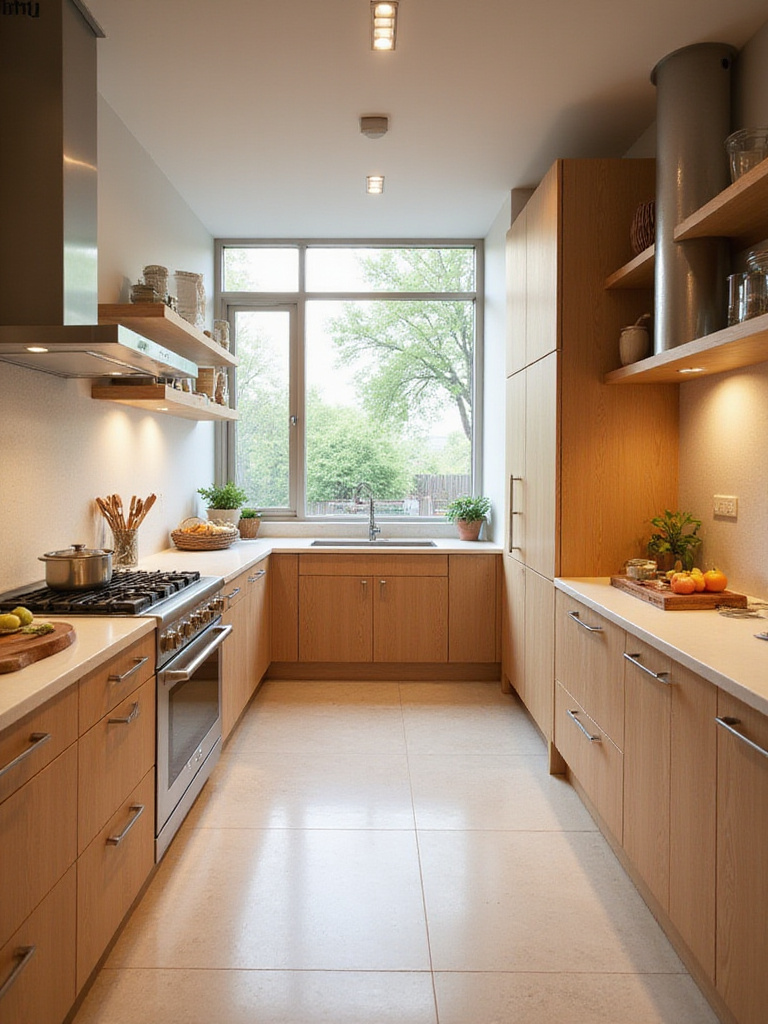
Beyond counter heights, consider the depth of counters (typically 25-26 inches), the height of upper cabinets (ideally allowing easy access to at least two shelves), and the placement of appliances. Wall ovens installed at eye level eliminate bending to check on food. Dishwashers raised 6-9 inches off the floor reduce back strain during loading and unloading. Microwave placement should suit the height of frequent users rather than automatically going above the range.
The challenge of awkward spaces becomes easier when you incorporate varied counter heights for different tasks. A 30-inch section for rolling dough, a 42-inch area for quick chopping, or a lowered section for children to help with meal prep can transform how you use your kitchen.
Color sets the emotional tone of your kitchen and influences everything from perceived spaciousness to energy levels while cooking. The classic 60-30-10 rule provides a useful framework: 60% dominant color (typically cabinets and walls), 30% secondary color (often countertops or backsplash), and 10% accent color (accessories and small appliances).

Different color schemes create distinct atmospheres. Classic neutrals (whites, grays, beiges) create a timeless, clean look that feels spacious and calm. Bold colors like deep blues or emerald greens create sophisticated, intimate spaces. Warm earth tones evoke a cozy, grounded feeling. Cool coastal palettes with light blues and sandy tones feel fresh and relaxing. High-contrast schemes like black and white offer graphic impact that’s both bold and classic.
The revival of this classic form comes with a twist as many designers now recommend testing your chosen palette under different lighting conditions throughout the day. Colors appear dramatically different in morning sunlight versus evening lamp light, and understanding these shifts helps prevent disappointing surprises.
Proper ventilation is one of the most overlooked kitchen design tips, yet it’s crucial for maintaining healthy indoor air quality. Cooking—especially on gas ranges—generates smoke, grease particles, moisture, and potentially harmful pollutants that need to be removed efficiently.
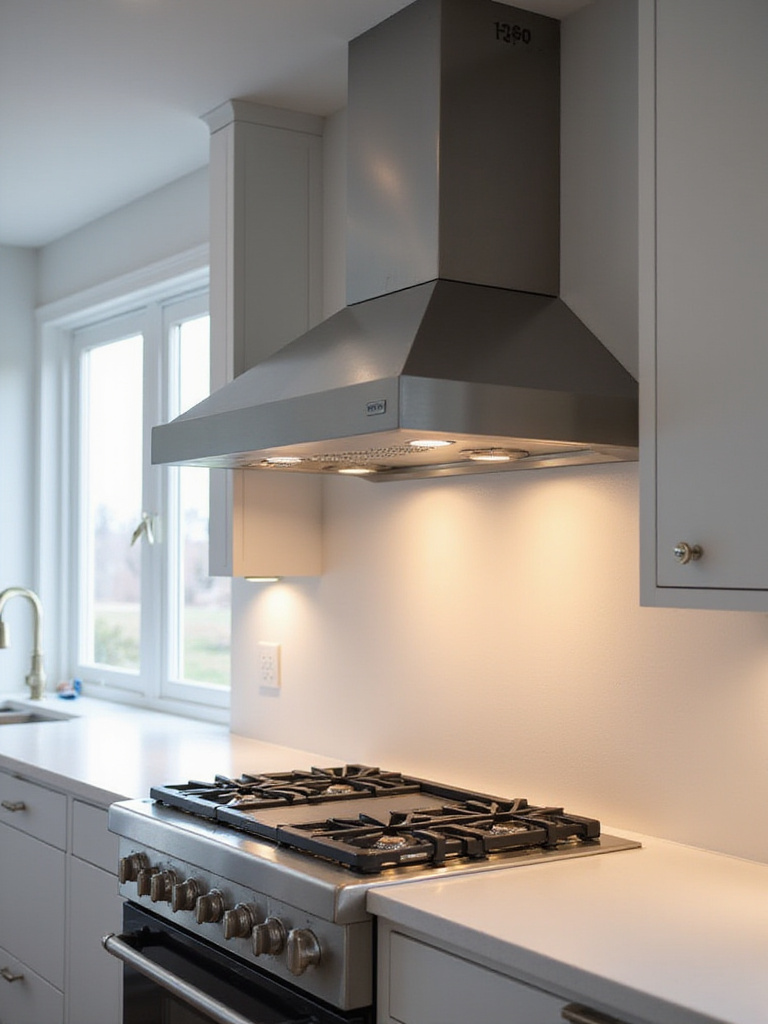
The two main types of hoods are ducted (which exhaust air outside) and ductless (which filter and recirculate air). Ducted systems are significantly more effective but require external venting. When selecting a hood, consider both width and power. The hood should be at least as wide as your cooking surface, preferably extending 3 inches beyond on each side. For power, measured in CFM (cubic feet per minute), calculate based on your cooking style: electric ranges generally need 100 CFM per linear foot of range width, while gas ranges require approximately 100 CFM for every 10,000 BTUs.
The environmental story behind this piece began with understanding that proper ventilation prevents grease and moisture from damaging your cabinetry and finishes, extending their lifespan and reducing waste. Regular cleaning of filters maintains optimal performance and energy efficiency.
The sink is the most frequently used fixture in many kitchens, making its selection particularly important. Size considerations should start with how you actually cook and clean. Deeper sinks (9-10 inches) contain splashes better and accommodate large pots, while wider sinks (30-36 inches) provide ample space for soaking baking sheets and cooling racks.
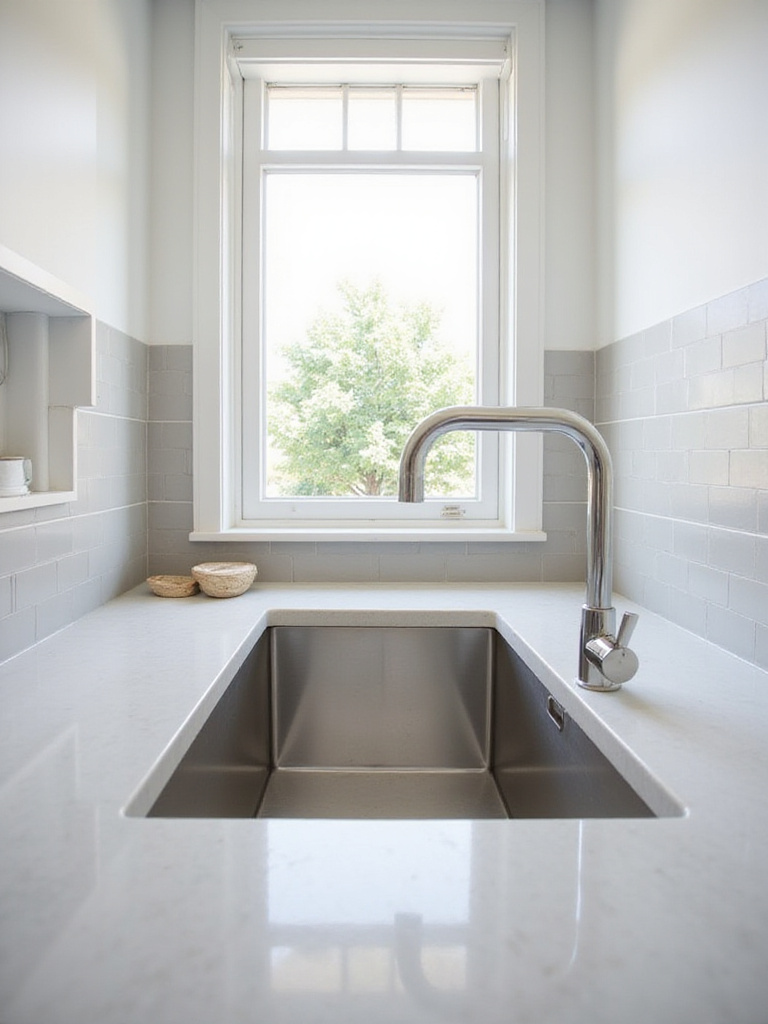
Configuration options include single bowls (maximizing space for large items), double bowls (allowing separation of tasks), and low-divide models (offering some separation while still accommodating large items). Installation styles include undermount (creating a seamless look with countertops), drop-in (easier to install but with a visible rim), farmhouse (with an exposed front panel), and integrated (molded directly into the countertop material).
What makes this design special is the way the sink can be transformed into a multifunctional workstation with accessories like cutting boards, colanders, and drying racks that fit over the basin. These additions effectively expand your usable counter space while keeping food prep centered around water access.
Faucets are the most interactive element in your kitchen, touched dozens of times daily. Function should lead your selection process, with style complementing your overall design. Pull-down faucets with high arcs work well with deeper sinks, while pull-out models offer greater reach. Single-handle designs allow one-handed operation when your hands are messy, and touchless models activate with a wave of your hand.
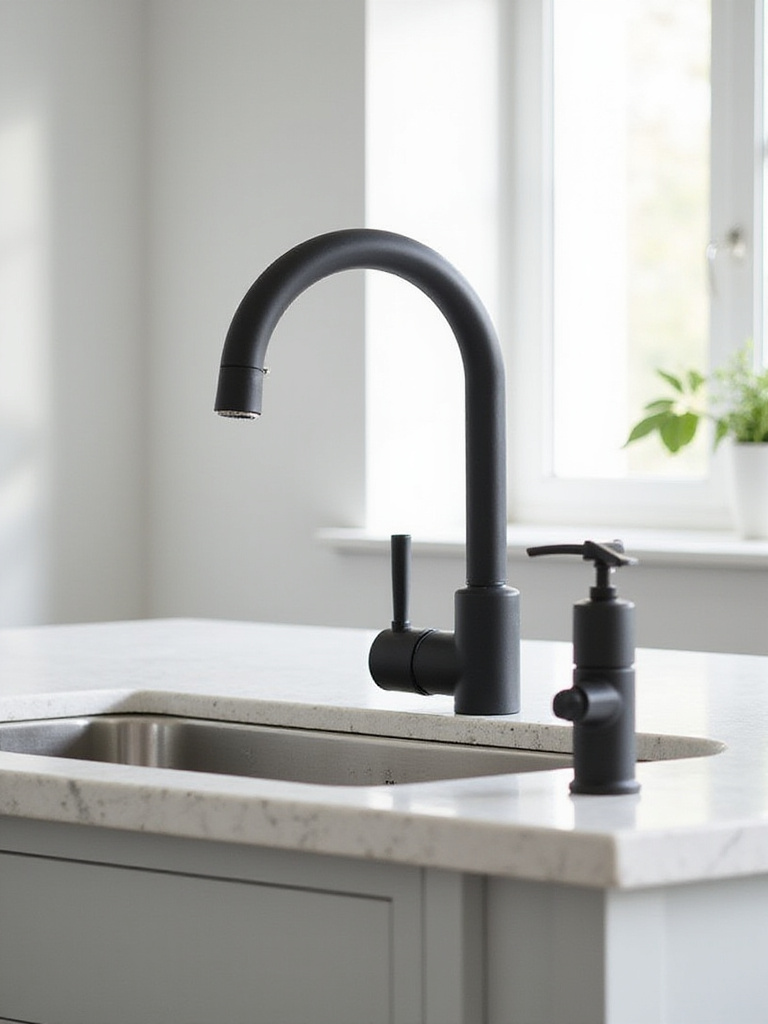
Material and finish choices affect both aesthetics and durability. Most quality faucets use brass internal components for longevity, with various external finishes. Chrome offers classic durability but shows water spots. Brushed nickel and stainless steel hide fingerprints and water marks better. Matte black creates bold contrast, while bronze finishes add warmth and often develop a patina over time.
The artisan’s journey behind handcrafted pieces has inspired many modern faucet designs that balance technological innovations with timeless forms. Features like magnetic docking for spray heads, temperature memory settings, and water-efficient aerators make these fixtures as functional as they are beautiful.
Islands and peninsulas have transformed from simple additional counter space to multifunctional hubs that often serve as the heart of the kitchen. Before adding either element, consider how it will function: Will it provide prep space, house appliances, incorporate seating, or some combination of these?
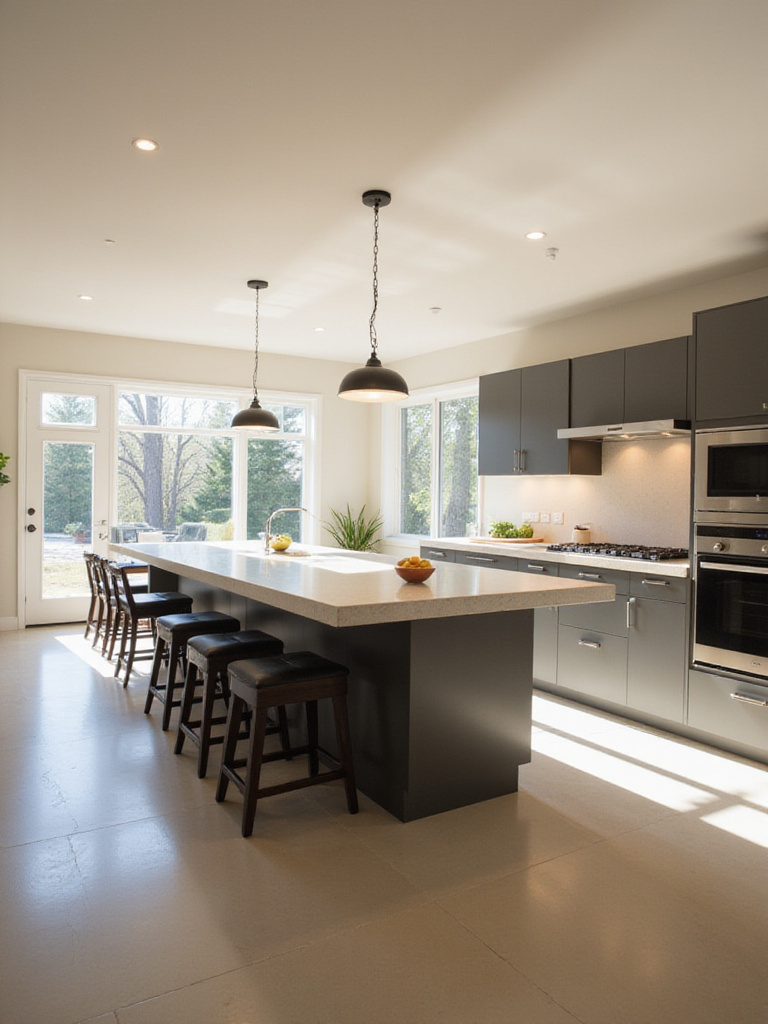
Proper clearance is non-negotiable for functionality. Allow at least 36 inches of walkway space around all sides that need access, and 42-48 inches between work zones facing each other across the island. For comfortable seating, plan 24 inches of counter width per person, with at least 15 inches of knee space depth and 12 inches of overhang. The overall dimensions should be proportional to your kitchen—too large will obstruct flow, too small will look insignificant.
The designer’s secret here is to use masking tape to outline the proposed island or peninsula dimensions on your floor. Walk around it, simulate opening appliance doors and drawers, and visualize how it affects traffic patterns before committing to construction.
Smart technology has moved beyond novelty to offer genuine improvements in kitchen functionality. From refrigerators with interior cameras that let you check contents while grocery shopping to ovens you can preheat remotely, these innovations save time and improve efficiency when thoughtfully integrated.
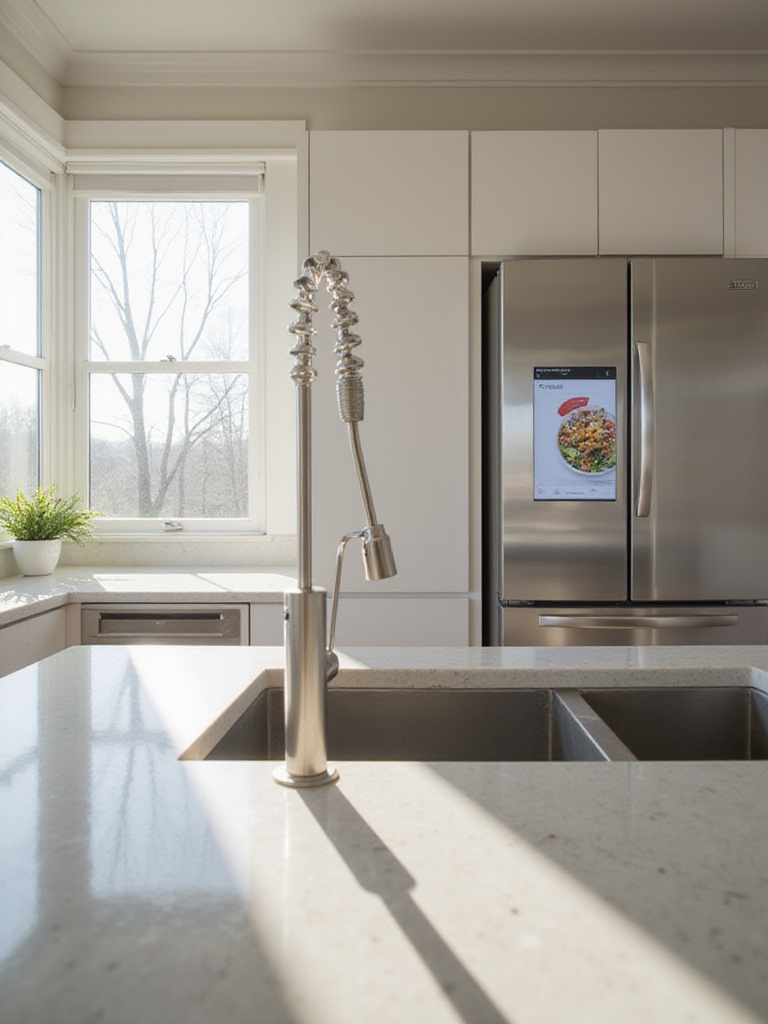
Voice-activated assistants can set timers, convert measurements, or add ingredients to shopping lists while your hands are occupied with cooking. Smart faucets turn on with a touch or voice command when your hands are messy. Connected lighting systems adjust brightness and color temperature throughout the day. Even smart outlets can monitor energy usage or shut off appliances remotely for safety.
The unexpected material discovery story of smart kitchen technology reveals that the most useful innovations are those that solve actual pain points in your cooking routine rather than simply adding technology for its own sake. Start by identifying your most frequent kitchen frustrations, then look for smart solutions specifically addressing those issues.
The debate between open shelving and traditional cabinets involves balancing aesthetics with practicality. Open shelving creates an airy, spacious feel and puts beautiful dishes and cookware on display. It offers easy access to frequently used items and adds personality to the kitchen. However, it requires consistent organization, regular dusting, and a curated approach to what’s displayed.
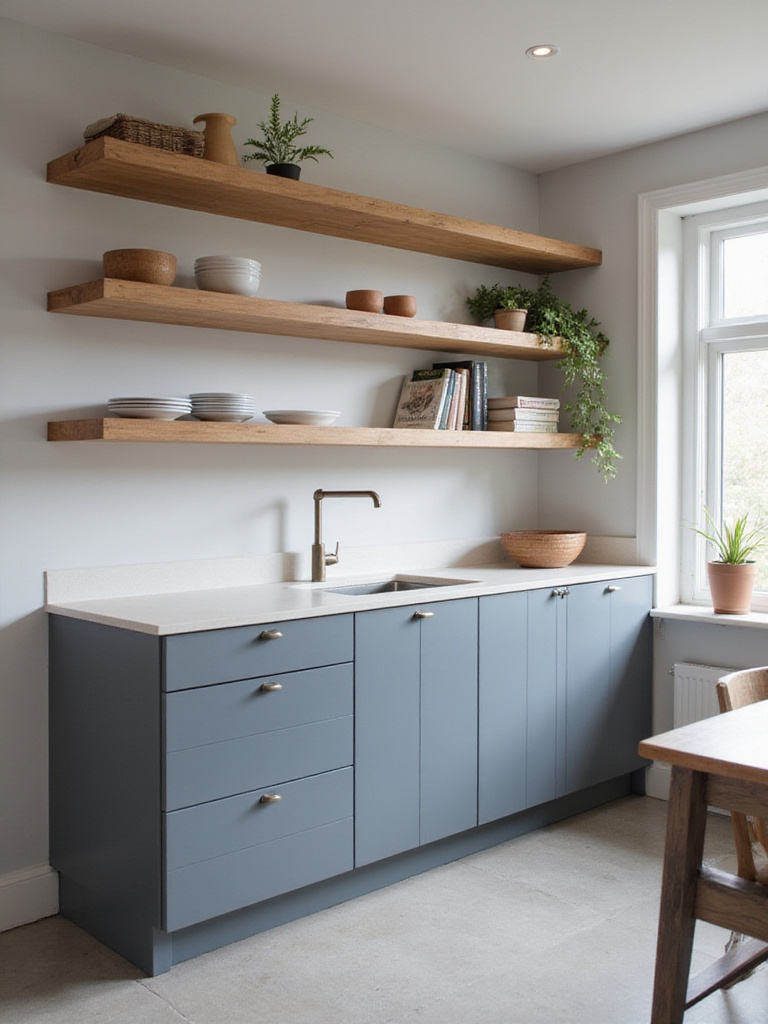
Closed cabinets provide clean lines and hide kitchen clutter effectively. They protect contents from grease and dust and typically offer more storage capacity. Upper cabinets with glass doors offer a middle ground—providing some display opportunity while keeping contents protected. Many kitchens benefit from a thoughtful combination, using closed storage for basics and open shelving for display-worthy items or frequently accessed essentials.
As morning light filters through, the texture creates different effects with open and closed storage throughout the day. Consider how natural light interacts with your kitchen when deciding between these options, as open shelving allows light to flow more freely through the space.
The backsplash offers a perfect opportunity to introduce personality into your kitchen through color, pattern, and texture. While traditional ceramic tile remains popular, consider unexpected materials like reclaimed wood, metal sheets, large-format porcelain slabs, or even a sheet of tempered glass over wallpaper for a unique look.
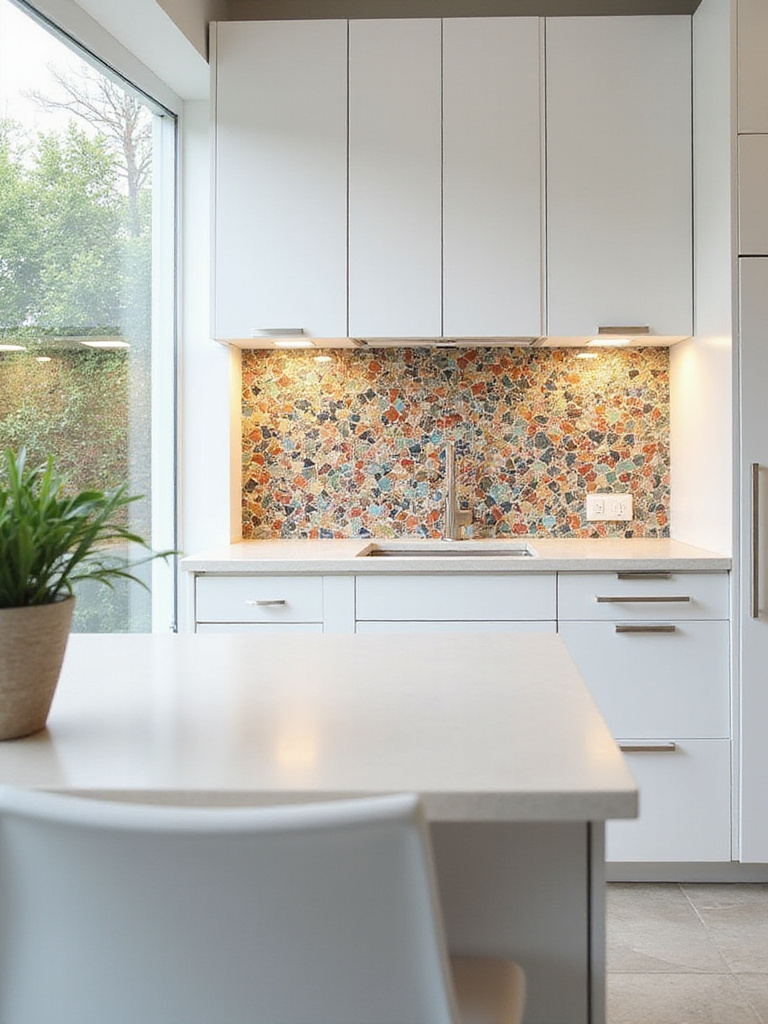
Even with conventional materials, installation patterns can dramatically change the effect. Subway tile installed in a herringbone pattern creates classic elegance with visual interest. Vertical stacking modernizes the same material. Creating a focal point behind the range with a different pattern or material draws the eye and creates a design feature, while using a simpler treatment elsewhere maintains balance.
The cultural heritage preserved in each piece includes centuries of ceramic traditions that have evolved into today’s incredible range of tile options. From hand-painted Spanish tiles to sleek, large-format porcelain, the backsplash connects your kitchen to broader design history while protecting your walls.
Kitchen flooring faces demanding conditions: spills, dropped utensils, constant foot traffic, and temperature fluctuations. Durability must be your first consideration, followed by comfort and aesthetics. Porcelain tile offers exceptional durability and water resistance with countless design options, though it can be hard underfoot. Luxury vinyl plank (LVP) provides impressive water resistance with more cushion and warmth, often convincingly mimicking wood or stone.
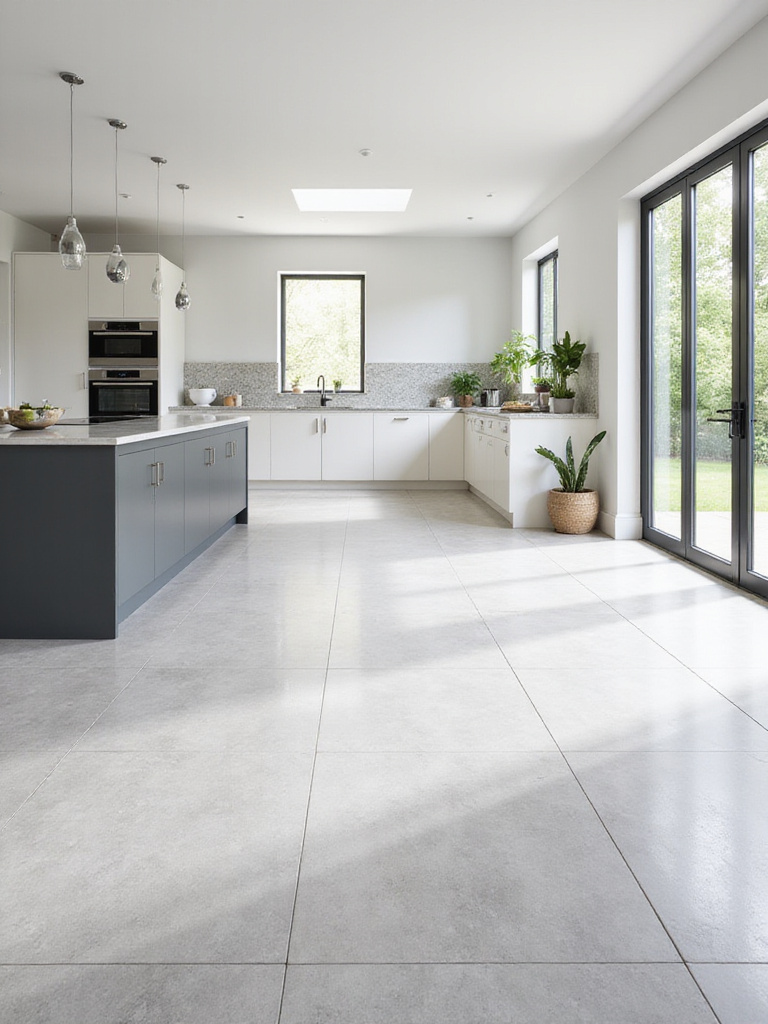
Natural stone like slate or granite offers timeless beauty but requires sealing and maintenance. Engineered wood provides the warmth of real wood with greater stability against moisture, though it still requires prompt spill cleanup. Cork offers natural cushioning and sound absorption but needs regular sealing. Each option balances different priorities—consider which factors matter most in your kitchen.
The sustainable journey of this material involves understanding that flooring with longer lifespans ultimately consumes fewer resources, even if the initial investment is higher. Look for options with recycled content or sustainable manufacturing practices to further reduce environmental impact.
Hardware is the jewelry of your kitchen—small details that make a significant impact on both function and style. Knobs, pulls, and handles should complement your overall design while providing comfortable, practical operation. Their material and finish often echo other metal elements like faucets or light fixtures for cohesion.
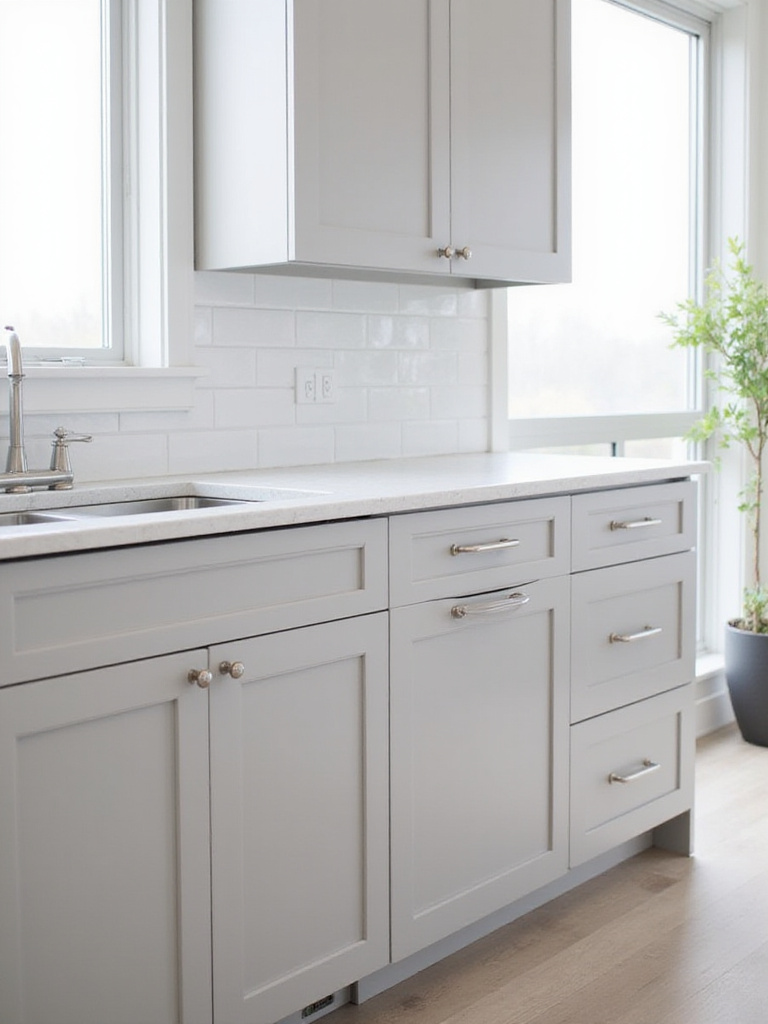
Consider the ergonomics of your hardware choices. Pulls typically offer easier gripping than knobs, especially for drawers containing heavy items. Many kitchens benefit from a mix—perhaps knobs for doors and pulls for drawers. Placement matters too: horizontal pulls on drawers and vertical pulls on tall cabinet doors follow the natural direction of opening and provide the best leverage.
The interplay between the colors creates subtle connections throughout the space when hardware finishes relate to other kitchen elements. This attention to detail elevates the entire design while improving daily functionality.
A well-designed pantry transforms food storage from chaotic to controlled. Whether you have a walk-in pantry, pull-out pantry cabinets, or dedicated cabinet space, organization principles remain the same: group similar items together, prioritize visibility and accessibility, and implement systems that maintain order.
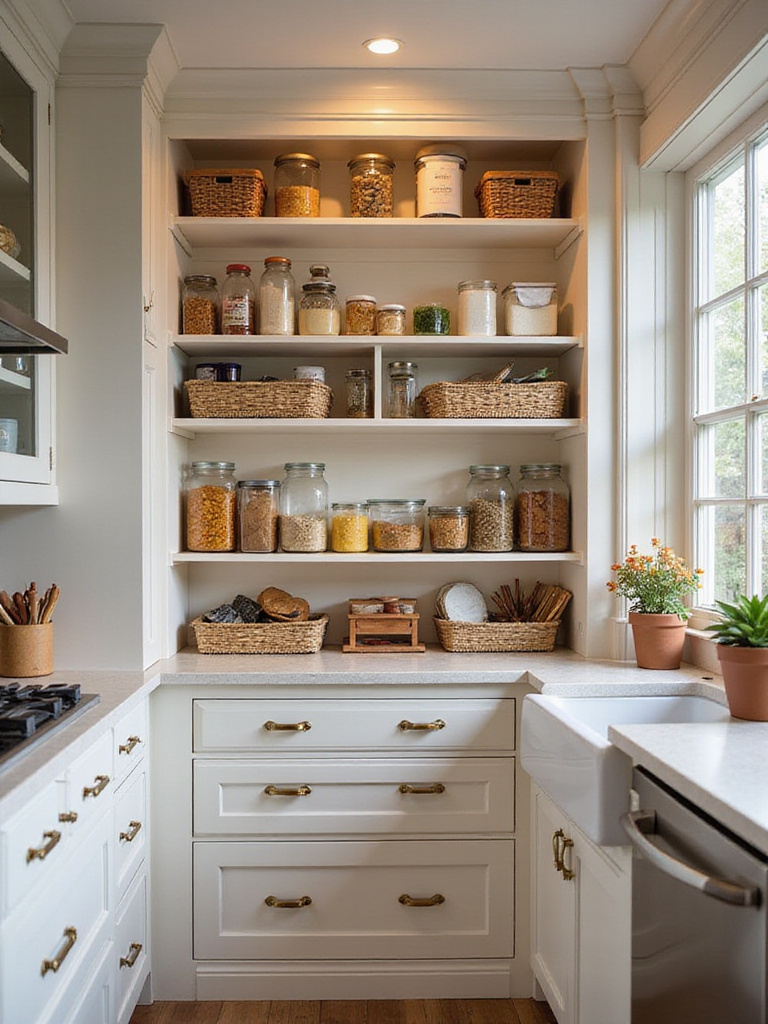
Clear containers for dry goods like flour, pasta, and snacks create visual calm while keeping contents fresh and visible. Adjustable shelving accommodates items of various heights. Pull-out drawers or baskets make accessing items at the back much easier. Door-mounted racks utilize otherwise wasted space for spices or small packaged goods. Labels ensure everyone in the household maintains the system.
For those worried about maintenance, remember that pantry organization isn’t about perfection but functionality. Start with the zones you access most frequently, and implement simple systems that are easy to maintain rather than complex arrangements that quickly break down.
Waste management is an essential kitchen function that’s often treated as an afterthought. Integrating trash and recycling bins into your cabinetry keeps them accessible but out of sight, improving both aesthetics and functionality. Pull-out systems with multiple bins allow for easy sorting of trash, recycling, and even compost.
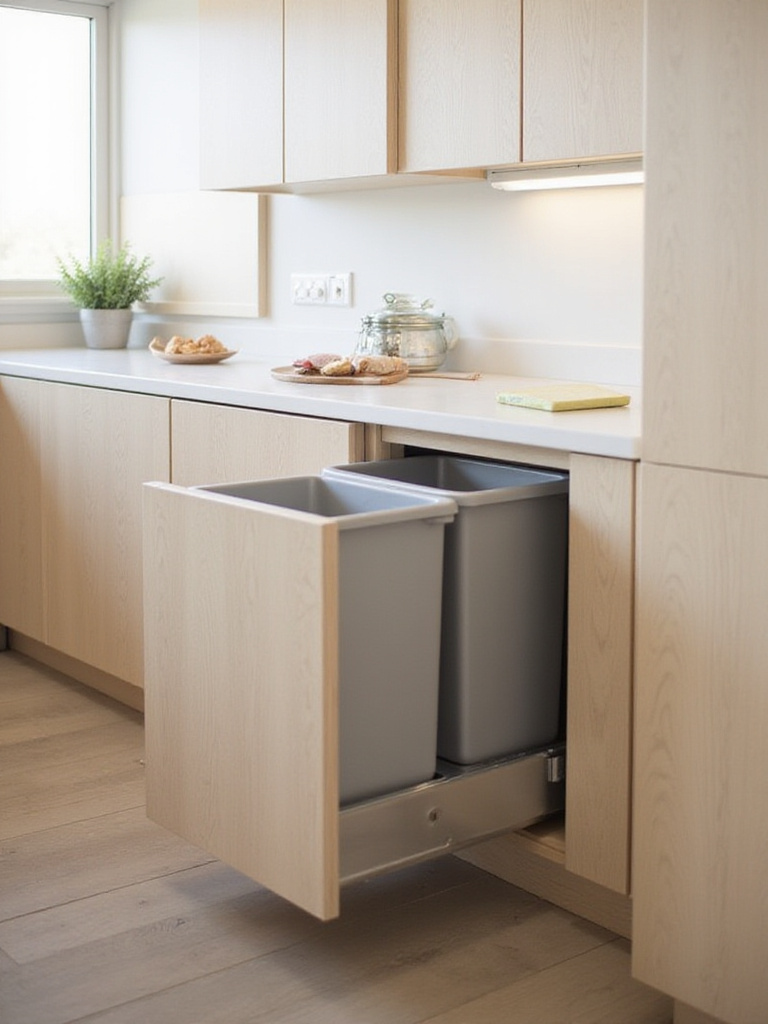
The ideal location for integrated waste bins is near the primary food prep area and sink, allowing for simple transfer of food scraps and packaging during cooking and cleanup. Consider your household’s waste volume when selecting bin sizes—undersized bins require frequent emptying, while oversized ones waste valuable cabinet space. Some systems include odor-control features like charcoal filters or airtight seals.
Unlike conventional options, this approach reduces visual clutter while encouraging better recycling habits. When waste sorting is convenient and well-designed, it becomes an effortless part of your kitchen workflow rather than an eyesore or annoyance.
Incorporating comfortable seating transforms the kitchen from a purely functional workspace into a true living area where family and friends naturally gather. Options range from built-in banquettes that maximize space efficiency to casual island seating or a small bistro table in a corner or bay window.
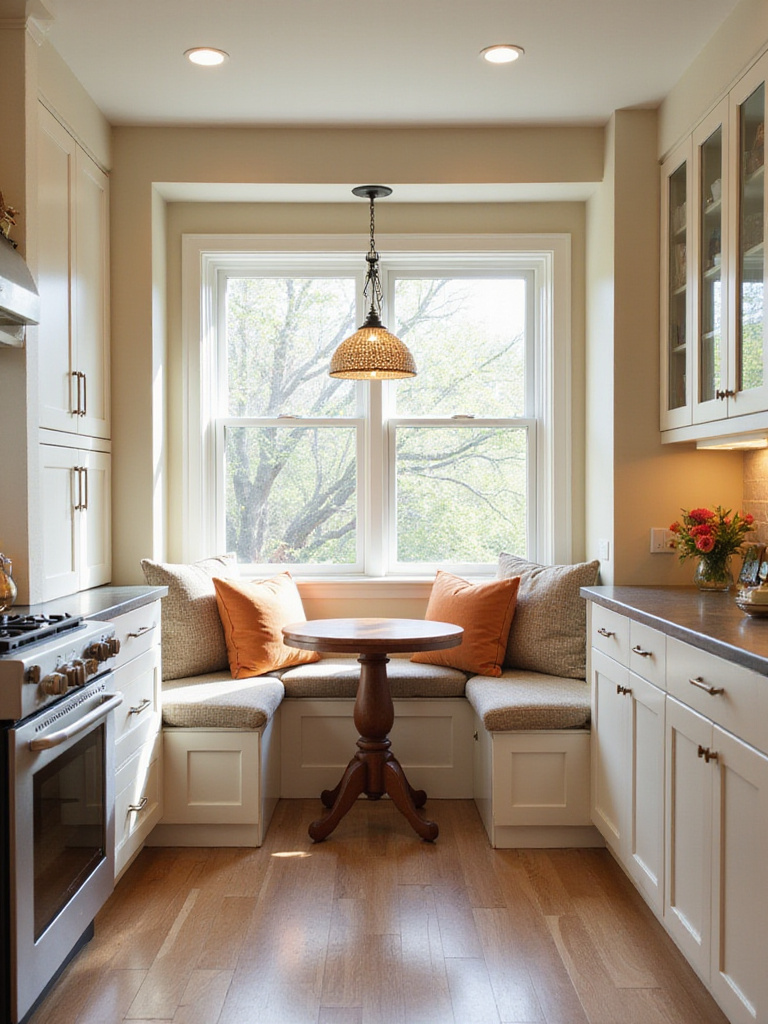
Consider the activities this seating will support—quick breakfasts, homework sessions, casual conversations while cooking, or full meals. This determines the type of seating, table surface, and clearances needed. Built-in banquettes often incorporate storage underneath, maximizing functionality. Island seating works best when the counter extends at least 12 inches to provide adequate knee space, with 24 inches of width per person.
The emotional response this evokes begins with creating a space that invites lingering rather than just efficient food preparation. These seating areas often become the most used spaces in the home, where daily life unfolds naturally around the kitchen’s warmth.
Kitchen windows require treatments that can withstand the unique challenges of this environment—moisture, occasional splashes, cooking grease, and frequent cleaning. Function should lead your selection process, with privacy, light control, and ease of maintenance as primary considerations.
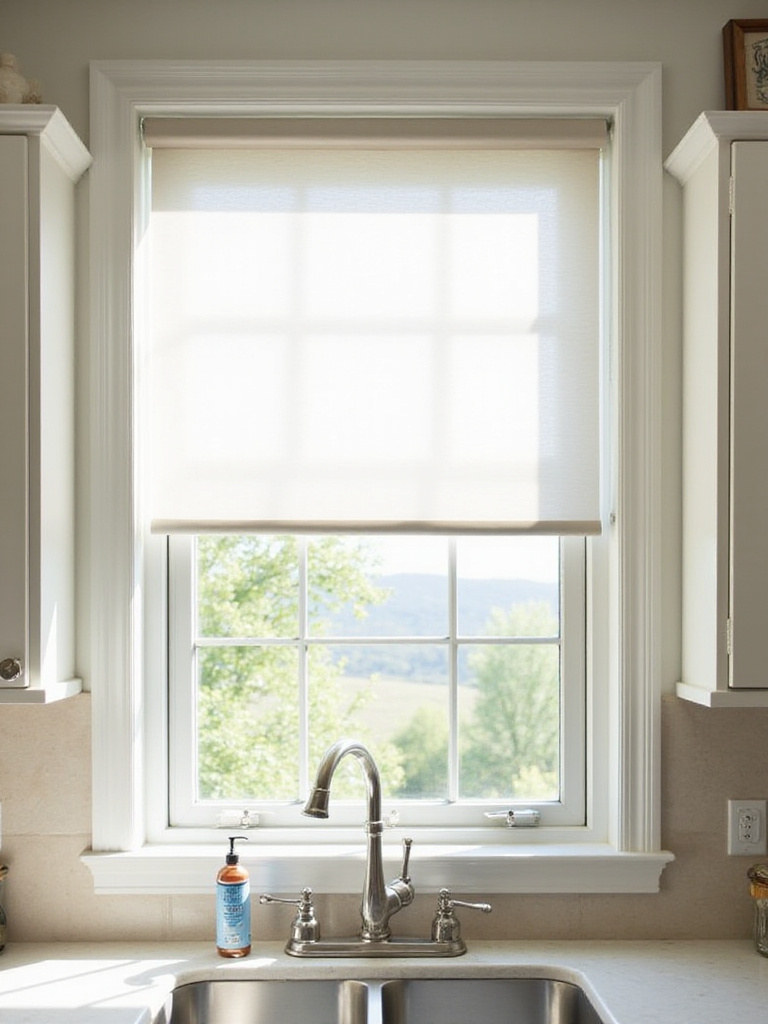
Materials matter significantly in this environment. Faux wood or vinyl blinds resist moisture and wipe clean easily. Roller shades in washable fabrics or vinyl offer simplicity and minimal dust collection. Cafe curtains that cover only the bottom half of windows provide privacy while maintaining natural light. For windows near cooking areas, avoid treatments with excessive fabric that could present a fire hazard or absorb cooking odors.
The composition comes together when you consider how window treatments interact with the overall kitchen design. They can provide a pop of color or pattern in an otherwise neutral kitchen, or maintain a clean, minimal look that lets other design elements take center stage.
Plants add a vibrant, living element to kitchen design that softens hard surfaces and connects indoor spaces with nature. Beyond their aesthetic appeal, they improve air quality, add humidity, and create a sense of well-being. The kitchen’s warmth and humidity often create excellent growing conditions for many plants.
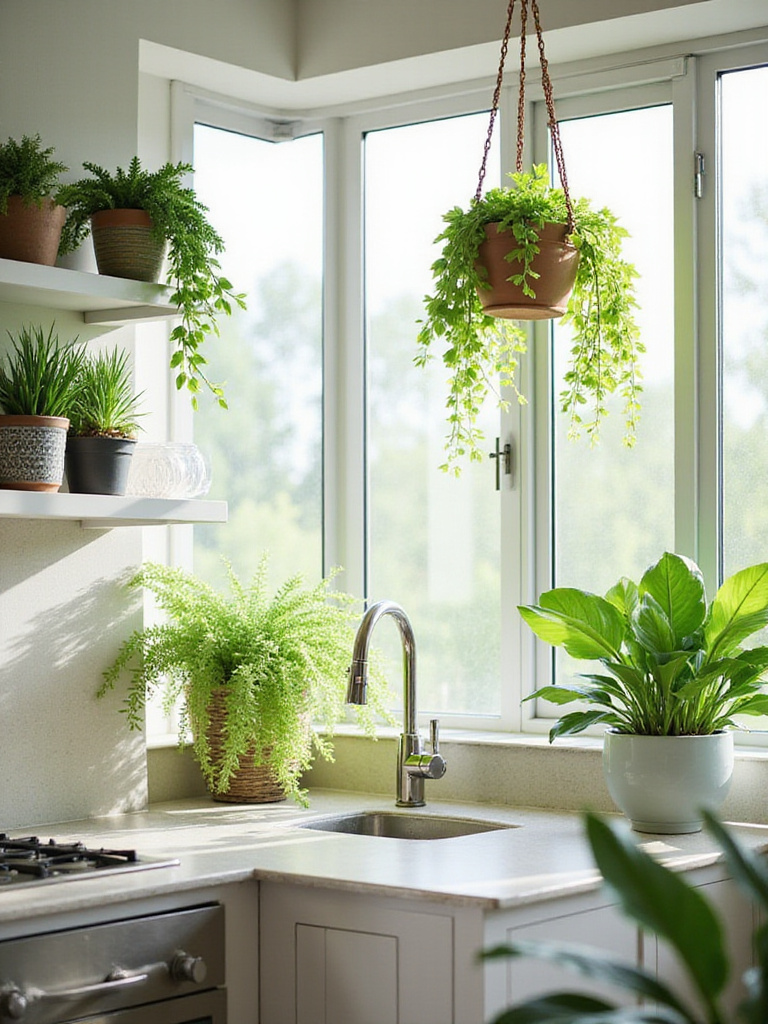
Select plants based on your kitchen’s specific light conditions and your maintenance capacity. Herbs like basil, mint, and rosemary thrive on sunny windowsills while providing fresh flavors for cooking. For moderate light, consider snake plants, pothos, or ZZ plants that tolerate varied conditions with minimal care. Hanging plants or trailing varieties maximize vertical space without consuming valuable counter area.
The subtle fragrance fills the room while adding a sensory dimension to your kitchen experience. Aromatic herbs release their scent when brushed against or harvested, creating an immersive connection between your garden and cooking.
A realistic budget is the foundation of a successful kitchen project. Understanding typical cost breakdowns helps you allocate funds effectively: cabinets (30-40%), labor (20-30%), countertops (10-20%), appliances (10-15%), flooring (5-10%), lighting (5-10%), and fixtures. These percentages vary based on your priorities and selections.
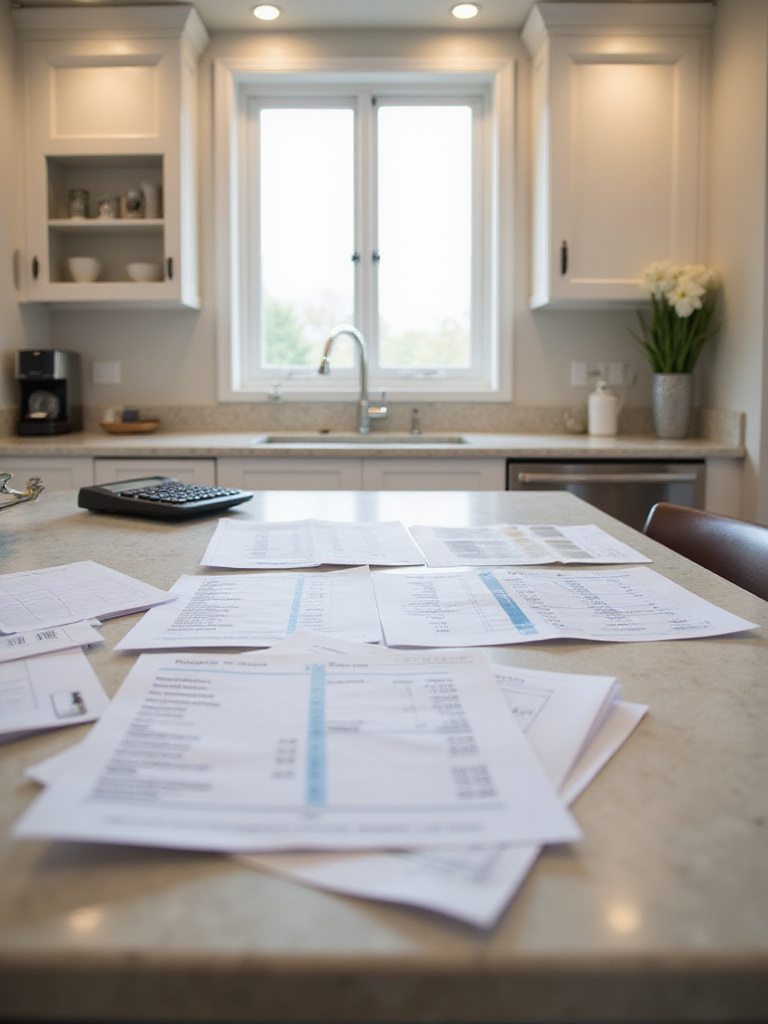
The most important budgeting advice is to include a substantial contingency fund—ideally 15-20% of your total budget. This buffer accommodates unexpected issues that inevitably arise during renovation, especially in older homes where plumbing, electrical, or structural surprises often hide behind walls. It also allows flexibility for small upgrades or adjustments as the project progresses.
Beyond aesthetics, the ecological impact matters because kitchen renovations generate significant waste. Budgeting for proper disposal, recycling of materials, and selecting sustainable options may add initial costs but reduces environmental impact and often creates healthier living spaces.
Professional kitchen designers bring specialized expertise that can transform good kitchens into exceptional ones. Consider hiring a designer if your project involves structural changes, complex layout challenges, or significant investment. Their knowledge of spatial planning, materials, and building codes prevents costly mistakes while maximizing functionality.
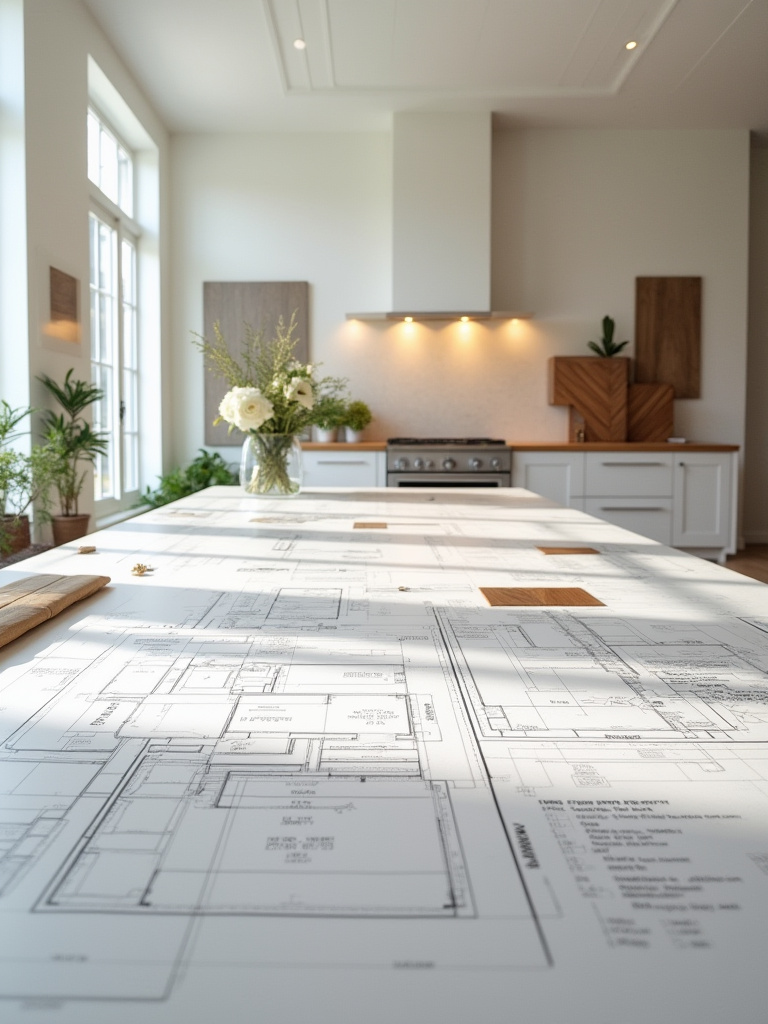
Designers provide value through optimized space planning, materials expertise, problem-solving, budget management, and aesthetic cohesion. They often have access to trade resources and established relationships with contractors. While their services add cost to your project, they typically save money in the long run by preventing expensive errors and helping you make informed decisions that align with your budget and goals.
When clients ask us about balancing style with comfort, professional designers excel at creating kitchens that look beautiful while truly supporting how you live and cook. Their training helps them translate your lifestyle needs into functional design solutions you might not have considered.
A kitchen designed entirely from trends without personal touches will never feel truly yours. Incorporating elements that reflect your personality, interests, and history transforms a functional space into one that tells your story. This might mean displaying a collection of vintage cookbooks, incorporating a backsplash tile pattern from your travels, or using a bold color that simply makes you happy.
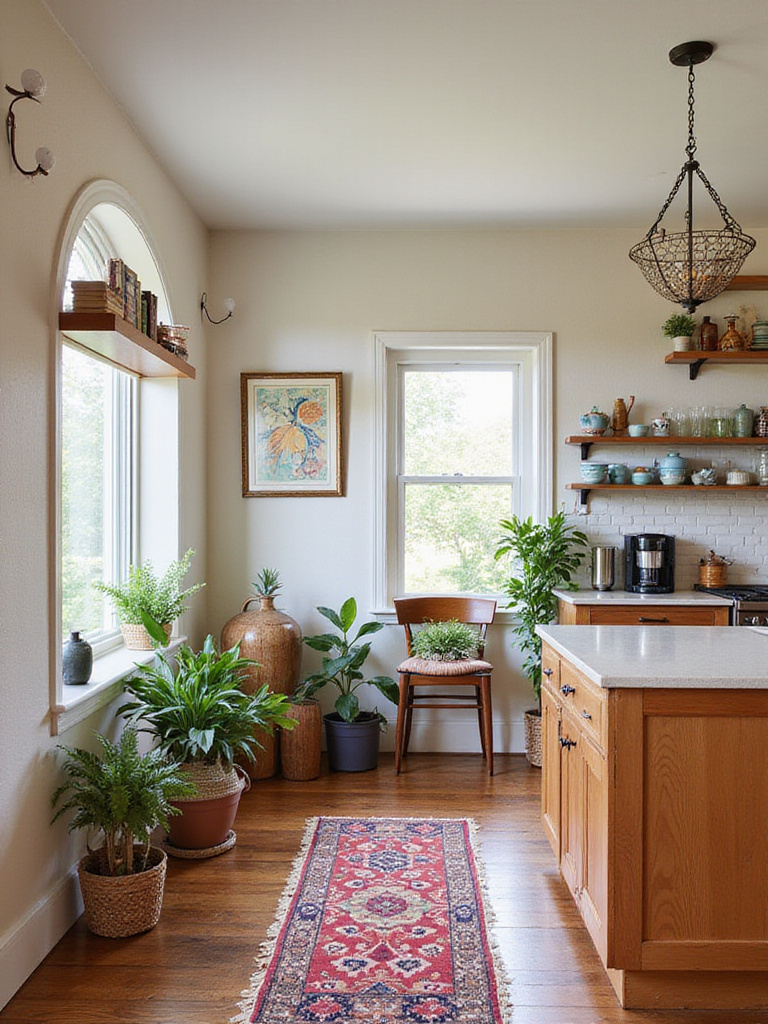
Personal touches don’t require sacrificing function or creating clutter. Consider open shelving for displaying meaningful items, glass-front cabinets for showcasing special dishware, or a gallery wall of family recipes or food-related art. Even small elements like uniquely shaped cabinet hardware or unexpected light fixtures can add personality while maintaining a cohesive design.
The finishing touch that elevates the entire look comes from these personal elements that can’t be replicated from a showroom or catalog. They create a kitchen that feels authentically yours—a space where memories are made and shared through the universal language of food.
The most successful kitchen designs balance timeless principles with personal expression. By incorporating these kitchen design tips, you create a space that not only looks beautiful but genuinely enhances how you cook, gather, and live. Remember that functionality forms the foundation—the work triangle, efficient storage, proper lighting, and durable materials—while personal touches add the soul.
Your kitchen should reflect how you actually live rather than how you think you should live. Whether you’re an enthusiastic home chef who needs professional-grade equipment or someone who primarily reheats and assembles simple meals, your kitchen design tips should support your real lifestyle. With thoughtful planning and attention to both practical needs and aesthetic desires, you’ll create a kitchen that truly becomes the heart of your home—a place where function meets joy in everyday living.